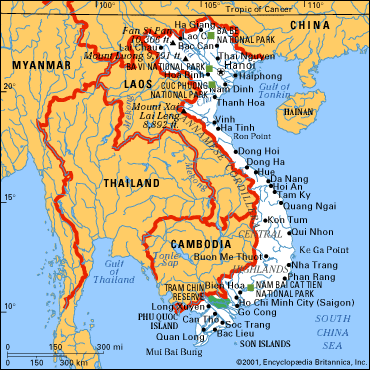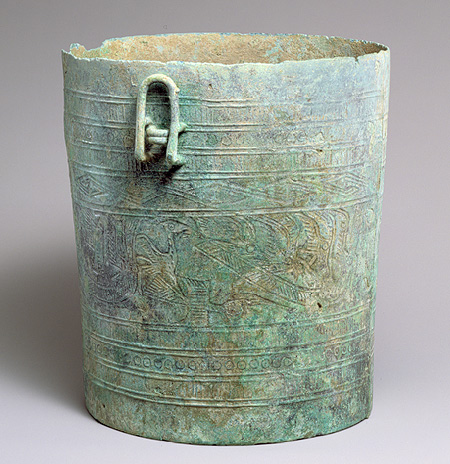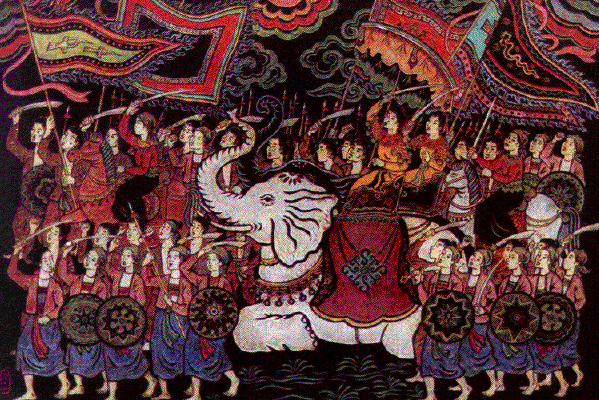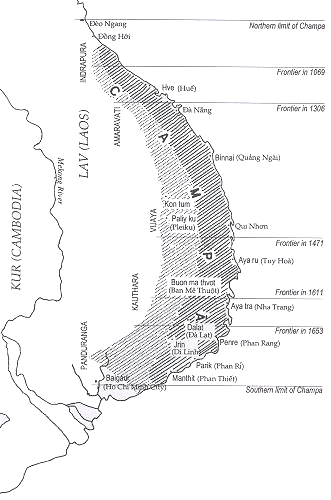
Keynotes 8
China's influence on Vietnam - Vietnam's Struggle for Independence

Map of Vietnam with Red River and Mekong River Deltas
Characteristics of early Vietnamese culture
1. Indigenous culture:
dominant role of women in society: matrilocality; jointly owned property;
Women:
- could inherit property
- managed household finances
- retained their family name after marriage AND passed it on to their children
- divorce was possible
- groom had to pay a bride-price (instead of bride's family providing a dowry)
- women participated in politics as diplomats and rulers
2. Indian influence
Theravada (Hinayana) Buddhism was adopted before Confucianism
(came with the Han occupation, but determined elite life from the 16th century
on); Sanskrit (in the southern kingdoms of Champa and Funan);
3. Chinese influences:
Confucian inspired administration; Chinese script:
Administration based on clan membership; conflicts between Confucianism, Buddhism,
Christianity; conflicts between Vietnamese and Mongols as well as local minorities
(Mong, Nung, Tho); rivalry between north (under Chinese influence) and south
(under Indian influence)
4. Agriculture:
Monsoon culture; vegetable culture (rice; vegetables -pumpkin, white beets;
fruit: water melons, papayas, aprikots, peaches, bananas, oranges, pomegranates;
corn, sesame, sugar cane; yams; harvest rhythm according to monsoon rains: in
the north in the 10th month, in the south in the 5th month); tea-, coffee-,
rubber-, tobacco- plantations
TIMELINE
Mythical stories give an account of the pre-historical proto-culture from which the Vietnamese originated; a mythical cultural hero invented the plough, developed the cultivation of rice, and discovered the healing effect of medical herbs; the spirits of the ancestors teach all humans the knowlege necessary for survival; benevolent and evil spirits (like the evil fish and fox ghosts, and an evil tree ghost) support or inhibit human existence; the use of tattoos to ward off evil spirits of animals living in water was widespread; teeth were covered with black lacquer.
6000 B.C.E. Hoabinh Culture in Northern Vietnam (Red River valley caves): agiculture, permanent settlements; population of Melanesian, Australian, Indonesian, Mongolian origin; production of food surplus and food storage vessels; pigs and chicken domesticated; vegetable civilization: growing of peas, beans, almonds, peppers, cucumbers
Burial practices were similar to other Southeast Asian areas (Indonesia, Philippines): bodies were buried under mollusk shell mounds in a seated position with bent knees
4500 B.C.E. Dongson Culture ("Formation period of the 'Vietnamese nation' " identified with the frist indigenous kingdom of Vietnam): stone, iron, bronze tools; weapons and musical instruments; cultivation of roots and millet; bronze production (lost wax method): ritual drums portray houses on bamboo stilts and everyday activities of the people: farming, pounding rice etc. Depicted animals: frogs, sea birds, deer. Warfare scenes: dancing men wearing feather headdresses and holding spears.

Bronze vessel of the Dongson Culture
3000 BCE Agriculture extends to the Red River Delta
257-207 BCE Kingdom of Au-Lac: When the Qin dynasty collapsed, Vietnam became independent from Chinese rule after Qin Shihuangdi had occupied Vietnam with 50,000 soldiers; the administration remained shaped after the Chinese model
3rd cent. BCE State of Yue with a double capital system extended from Southern China (Guangdong) to northern Vietnam
capitals: Guangzhou; Hanoi
111 BCE - 939 CE occupation under Han emperor Wudi; Vietnam becomes a Chinese province; politics, economy, social organization are influenced by China: Chinese script is used
39/41 CE Sprouts of Vietnamese nationalism: A Vietnamese noble is executed by the Chinese occupation administration; his wife is raped; the widow and her sister create a resistance movement by raising an army that defeats the Chinese army; only two years later the Chinese return and the patriotic sisters Trung Trac and Trung Nhi commit suicide by drowning themselves; they are revered as national heroines ever since - a temple is dedicated to their memory in Hanoi

Trung Trac and Trung Nhi fighting the Chinese occupation forces (modern lacquer work)
Chinese General Ma Yuan occupies northern and central Vietnam with 20,000 troops to the imperial capital Hue
500 to 982 CE the kingdoms of (Malay-) Champa (writing system Sanskrit) and (Cambodian) Funan (Indian influence; official language: Sanskrit) disolve under Vietnamese occupation and are integrated into the Vietnamese state;
 Map
of Champa
Map
of Champa
Map of Funan
541 Ly Bi rebels against the Chinese occupation; he is assassinated 6 years later
During the Chinese occupation under the Han and Tang Dynasties many Vietnamese young men travel to China to participate in the Chinese education system. In the Tang, Mahayana Buddhism and Theravada Buddhism melt into a Vietnam-specific Buddhist culture; the process becomes visible in secular and religious architecture: stupas/ Indian influence; palaces and pagodas /Chinese influence


Buddhist temple in Hue

Buddhist stupa

Pagoda
The Period of Independence (939-1885)
938-967 Ngo Dynasty and period of 12 Warring States
968-979 Dinh Dynasty: reunification; acknowleges Chinese superiority by becoming a tributary state to China which Vietnam remains until the fall of the Qing Dynasty in China in 1911:
Vietnam sends local products to the Chinese court and acknowledges Chinese superiority, in return China sends gifts, predominantly silk payments and educates the Vietnamese aristocratic youth in the imperial academy.
980-1009 Early Le Dynasty; occupation of the Champa capital Indiapura (982)
1010-1428 The Ly and Tran Dynasties
copy Chinese government institutions and the Chinese examination system for
their administration; 1075: introduction of state examinations according to
the Chinese model; 1076: founding of the college for the imperial princes; 1086
founding of the imperial academy; 1171 first map of Vietnam compiled on imperial
order; Buddhism flourishes; development of the Nom-script by transforming Chinese
characters

Nom script: one character gives the sound (pronunciation), the other character
the meaning.
1253 founding of the imperial military
academy
1257, 1285, 1287 Mongol successless invasions in Vietnam; tributary relation
with Yuan China
1406 invasion of Vietnam by troops of Ming Emperor Yongle;
1400-1407 Ho Dynasty: introduction of free schools in the cities
1413-1428 Chinese occupation: introduction of Chinese official clothing, taxes,
corvee labor in the mines; hunting of elephants, confiscation of pearls
1418-1427 uprisings against the Chinese occupation which result in the withdrawal
of Chinese troops
1428 -1789 Later Le Dynasty:
re-organization of the administration, land reform, re-opening of schools and
universities; new law code: protection of private property; limitation of officials'
rights; protection of women's rights; officially proclaimed 'moral code'
1527 General Mac Dang Dung collaborates with the Chinese in order to remove the rivalling Le and Nguyen families from power positions in the north and south respectively
1674 -1740 Civil War between the Trinh (Tongking) and Nguyen (Annam) clans which both claim loyalty to the Le Dynasty emperor; Vietnam is divided in the center for the first time. The Nguyen controlled the export of gold, silver and iron and were supported by the Portuguese; they retreat to Hue; the Latin script is adapted for the Vietnamese language; [the adaptation is developed by a French Jesuit]
[1680 The French East India Company openes a trading bureau at Pho Hien in northern Vietnam which is abandoned again in 1700; French and Dutch trade companies used this bureau.]
1740 Vietnam is re-united
[1750 Christian missionaries are deported because of the growing influence of the missionaries; some Jesuits are allowes to remain at court in order to serve as advisors in scientific matters.]
1772-1787 Tayson Rebellion of the three Nguyen brothers; Emperor Nguyen Anh leaves his fleet during each spring season to fight the Tayson rebels ('War according to the Seasons')
[In 1787 Bishop Pigneau de Béhaine who came to Vietnam in 1767 arranges a treaty between France and the provinces of Cochin China which promises French military aid when needed (as it would have been helpful during the Tayson rebellion) in exchange for trade privileges; the promised aid never materializes]
1802 - 1945 Nguyen Dynasty: The first emperor defeats the Nguyen brothers. Vietnam is reunited
[1825 Emperor Minh Mang refuses to conclude a commercial treaty with France as proposed in a letter from Louis XVIII. Instead he issues a decree that outlaws the further dissemnination of Christianity in Vietnam.]
1840s The second emperor of the Nguyen Dynasty again tries to limit French influence and suppress Christianity; French and Vietnamese priests are killed;
[Further hostilities against French missionaries and Vietnamese Christians; on April 15, 1847 French warships sink five armoured junks of the Vietnamese navy in Da Nang harbor; Vietnamese authorities execute 2 French missionaries in 1851, one year later they execute a bishop.]
1859 In response the French seize Saigon and the three provinces of Cochin China;
1864 France establishes a protectorate over Cambodia
1867 three more provinced are brought under French control
1882 Hanoi is captured by the French; one year later China sends troops to assist its tributary state
1885 China has to leave Vietnam to its colonial fate by signing a treaty with France abandoning China's claims to Vietnam
1893-1940 France forms the Federation of Indochina (Vietnam,
Cambodia, Laos)
1884 Vietnam becomes a French colony
1915 The examination system is abolished
1940 Japanese occupation
1946 Democratic Republic
An Ambassador to China
Once upon a time there was a very gifted man, and the king sent him as ambassador to China. There the Chinese brought his cleverness to the test by inviting him to a banquet held at the top of a tower. He climbed the tower, but down below at the foot of the tower they took the ladder away. The man was at a loss; then he picked up two parasols and let himself fall. His extreme cleverness was extolled by all. The Chinese made another attempt and said to him: 'Go into the pagoda to see Buddha.' He went into the pagoda, and when he was inside, they locked the door. Our friend, inside, was at a loss. Some statues of Buddha made of flour and icing sugar had been put there, and our friend ate them all. Ten days later the Chinese unlocked the door, and saw that the statues of Buddha had all gone. They asked where they were, and our friend replied that the Buddhas were in his heart. (Vietnamese Folktale, translated by Landes; from Maurice M. Durand, An Introduction to Vietnamese Literature. New York: Columbia University Press 1985, p. 37)